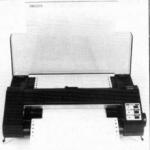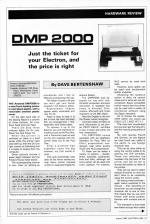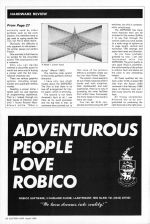
Electron User
 1st August 1986
1st August 1986
Categories: Review: Printer
Author: Dave Bertenshaw
Publisher: Amstrad
Machine: Generic
Published in Electron User 3.11
Just the ticket for your Electron, and the price is right
Amstrad DMP 2000
The Amstrad DMP2000 is a neat front-loading printer in matt black plastic, with a removable smoked plastic cover.
On the right hand side of the sloping fascia is a column of three buttons. On Line, Form Feed and Line Feed.
There are also three indicator lights, for On Line, Paper Out and Power On.
When the printer is switched on there is a brief pause while the printer head sets itself up, then the On Line light comes on indicating that it is ready to receive from the computer.
Other controls include a paper depth indicator and the Friction/Tractor feed switch.
The accompanying manual is very clear on setting-up procedures, and I met no difficulty in preparing it for use.
The ribbon is easy to fit and you don't get your hands covered in ink doing it, either.
Replacement ribbons appear easily obtainable and cost 5.70.
Paper is easy to load. It is fed in from the front and kept flat, an arrangement I like, especially with sheet paper.
To connect it up to the Electron you will need both an interface such as the Plus 1, and a Centronics lead as well as the one supplied with the printer does not fit the Plus 1.
After a problem-free assembly came the big moment, my first words in print.
This was surprisingly easy after all the horror stories you hear about printer manuals written in Japanese English for obscure Basics.
The DMP2000 was designed for use with non-Amstrad computers, and each instruction is repeated four times, in Amstrad, Commodore, Microsoft and (most important of all) BBC Basic.
Also the English is the sort the Queen would recognise.
A simple matter of VDU2 to send information to the printer, PRINT"HELLO", and there it was, black and white, my first masterpiece.
The DMP2000 comes equipped with six typefaces: Standard (or Pica), Mini (or Elite), proportional, condensed, near letter quality (NLQ) and NLQ proportional.
To these can be added a variety of options - double-strike, subscript, superscript, bold and italic, although not every option can be used with every typeface. For instance, NLQ cannot be used with italic.
However, every option can be used with double-width and/or underline.
Choosing the typeface option is done via control codes and is, as far as I can tell, completely Epson-compatible (which means that the printer can be used with a variety of commercial software using the Epson standard).
So to choose the double-width option, you would use VDU2,1,27,1,ASC("W"),1,1.
This may look complicated but you soon get the hang of it, and the manual gives plenty of help.
My wife teaches French and German, so one feature we have found very useful is the ability to use foreign character sets.
This can be done either by using the control codes by by altering the DIP switches. These tiny switches are recessed into the back of the printer and can be set to choose the power-up state of the printer.
They can be used to select various functions so that you don't have to be constantly using the control codes.
By setting these switches - again, clearly explained in the manual - then switching on the printer, you can change the character set to one of nine. This means that you can print French with acute accents, German with umlauts and so on.
The drawback is that these new letters occupy ASCII codes normally used by other symbols, such as the curly bracket. You therefore have to get used to typing words like tr}s, but this is easily learnt.
Obviously, the difficulty is only apparent on the screen - the printer spews out perfect French.
One anomaly is that there is no symbol for the circumflex accent. This could prove to be a nuisance. Only you can decide whether a circumflex accent is worth the extra cost of buying a printer with the full international character set.
There are various graphics options, including single, double and quadruple density modes.
Needing a screen dump I called upon my vast reserves of programming experience. That is, I looked through my back issues of Electron User until I found Roland Waddilove's article "What a dump!" (March 1985). The machine code version of this works perfectly without alteration.
I have only two slight moans about the DMP2000. The first is that there is no tear-off arrangement for tractor paper, which is annoying.
The second is not really Amstrad's fault at all. I use View as my word processor and the big flaw in that, as reviewers have pointed out, is that none of the printer's effects is available unless you buy the View Printer Driver.
The version I have seems to be out of date, because while it works well with underline, bold, doublewidth and sub/superscript, there is no way of accessing the other facilities from within View. Fortunately the driver listed in this month's issue can cope.
You can set NLQ, condensed and bold using the DIP switches, but this is unnecessarily complicated.
The DMP2000 has many more features than can be included in this review. Suffice it to say that through the control codes you have access to a wide range of options as to page length, vertical and horizontal TAB settings and paper feed rates and direction.
As you have probably guessed by now, I am very impressed with the DMP2000. The print quality is very good (NLQ is excellent), the workmanship of the printer is without fault and above all the price is very interesting indeed.
All these qualities set me back under 160, at least 60 less than the Epson LX80 reviewed in the February 1986 issue of Electron User and I didn't pay extra for the tractor feed.
All things considered, Amstrad are to be congratulated on producing the right features at the right price.
This article was converted to a web page from the following pages of Electron User 3.11.




